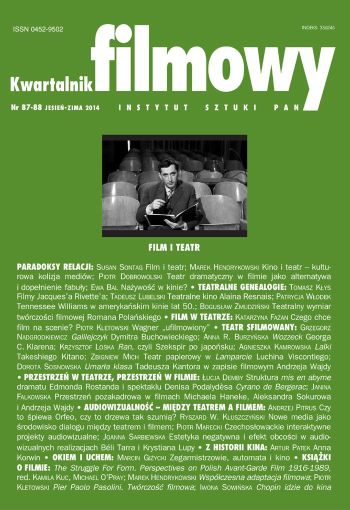Żywy teatr, martwe oko, umarli w piwnicy i buty trupa. Wokół "Umarłej klasy" Tadeusza Kantora w zapisie filmowym Andrzeja Wajdy
Live Theatre, Dead Eye, the Dead in the Cellar and the Shoes of a Deadman. On Tadeusz Kantor's "Dead Class" in Andrzej Wajda's film recording
Author(s): Dorota SosnowskaSubject(s): Theatre, Dance, Performing Arts
Published by: Instytut Sztuki Polskiej Akademii Nauk
Keywords: Kantor Tadeusz; Wajda Andrzej
Summary/Abstract: The article deals with the relationship between theatrical spectacle – "Dead Class" by Tadeusz Kantor – and its film recording by Andrzej Wajda. Starting from the thesis that this film rescued the spectacle and is an example of a master recording of a theatrical event, the author points out the definitions of theatre and film on which this conviction is based. Sosnowska in her analysis of Wajda’s statements on the recording of the Dead Class and his theatrical practice, points out the paradoxes resulting from understanding theatre as a “life performance”, ephemeral and in need of a rescue, and film as a dead and lasting medium. Following the points made by Rebecca Schneider, the author suggest that we look at the theatre in another manner – as a kind of an archive that uses other media, in order to survive in its performative way. Given such understanding, it turns out that the relationship between Kantor’s spectacle and Wajda’s film recording might be understood in a completely different way. The film not so much rescued the spectacle, but it turned it into a repetition of itself, becoming an essential element of the "Dead Class".
Journal: Kwartalnik Filmowy
- Issue Year: 2014
- Issue No: 87-88
- Page Range: 197-204
- Page Count: 8
- Language: Polish

